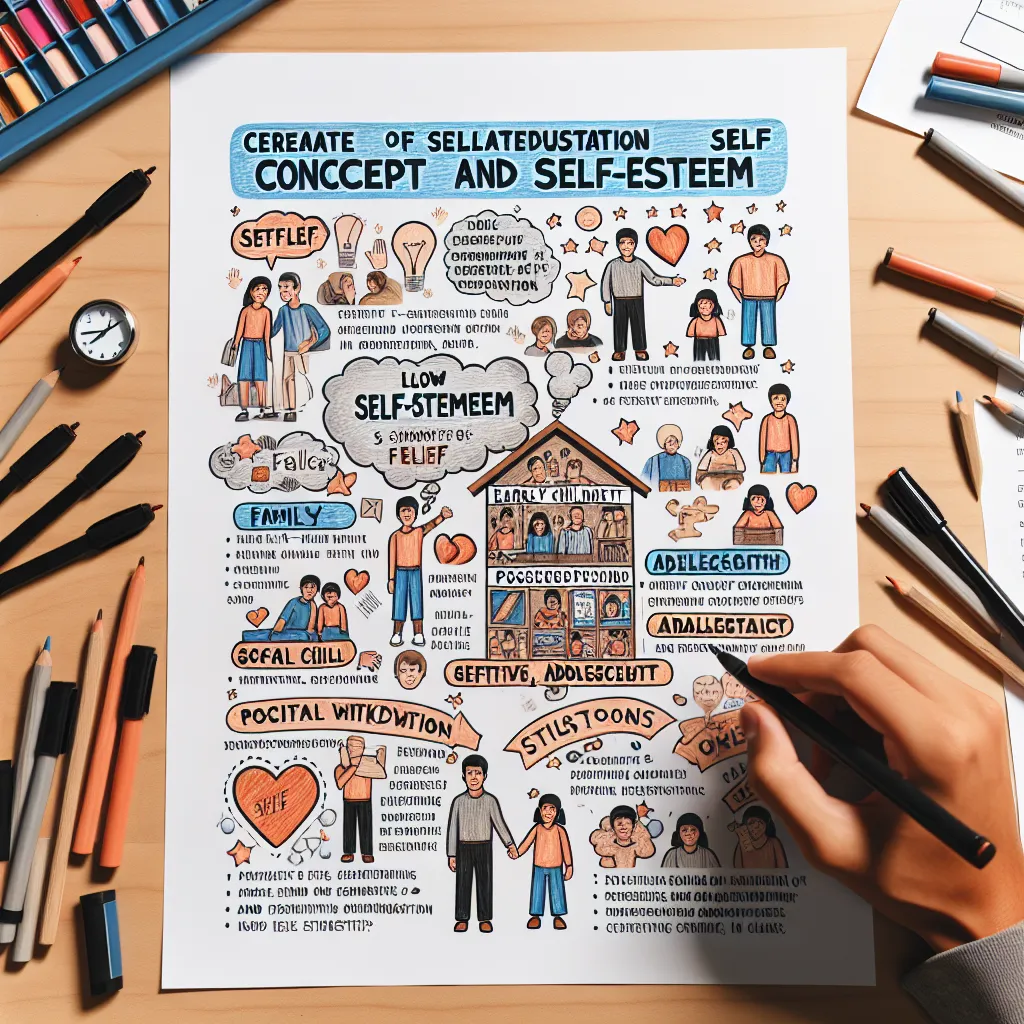Ask AI on The Internet
Question: Erikson's theory of social development outlines what children need to develop socially and emotionally, as well as how adults in the society in which they grow contribute to their later development (Woolfolk 2014). Erikson writes about the emergence of the self, the search for identity, and the creation of relationships that are vital for children's social and emotional development in this theory" (CDE2601 Study Guide 2024:124). 1.1 Critically discuss the relationship between self-concept and self-esteem, and how they develop over time. Provide TWO (2) examples to illustrate the changes in self-awareness and self-evaluation from early childhood to adolescence. (5) 1.2 Critically explain the role of the family in shaping a child's self-esteem according to Erikson's perspective. Provide TWO (2) real-life examples to support your explanation. (6) 1.3 Design a table to illustrate FOUR (4) positive and negative interactions within the family environment that influence a child's self-concept and self-esteem. (5) 1.4 Imagine you are a teacher in a Grade R classroom. Discuss TWO (2) specific strategies and TWO (2) potential outcomes addressing how you would design activities or classroom discussions to foster positive self-esteem and selfconcept amongst your learners. (6) 1.5 Describe the potential long-term effects of low self-esteem on a child's overall development and well-being by discussing how experiences and interactions during childhood might contribute to the development of low self-esteem.
Certainly! Let's address each of your points step-by-step. ### 1.1 Relationship Between Self-Concept and Self-Esteem **Self-Concept** refers to an individual's understanding of themselves, including their attributes, who they are, and what they believe in. It develops through social interactions and personal reflections. **Self-Esteem**, on the other hand, is the evaluative and emotional aspect of the self-concept. It refers to how much value people place on themselves. **Development Over Time:** - **Early Childhood:** Children begin with a rudimentary self-concept, often based on concrete criteria (e.g., "I can run fast" or "I have brown hair"). During this stage, self-esteem is generally high as children are not yet comparing themselves to others. - **Adolescence:** As cognitive abilities mature, adolescents develop a more abstract and complex self-concept, incorporating values, beliefs, and multiple facets of their identity. They become more self-conscious and start comparing themselves to their peers, which can influence their self-esteem significantly. **Examples:** 1. **Early Childhood:** A child in kindergarten might say, "I am good at drawing," reflecting a simple self-concept focused on specific skills and abilities. 2. **Adolescence:** A teenager might struggle with self-esteem issues when they compare their appearance or academic performance to that of their peers, which can result in a more nuanced but critical self-evaluation. ### 1.2 Role of the Family in Shaping Self-Esteem Erikson emphasized the critical role of caregivers and family in shaping a child's early sense of trust, autonomy, and initiative, which form the foundation for healthy self-esteem. **Family's Influence:** - **Positive Reinforcement:** Consistent encouragement and praise from parents promote a child’s self-worth and confidence. - **Supportive Environment:** Families that provide emotional support, security, and acceptance help build a child's resilience and self-esteem. **Examples:** 1. **Positive Influence:** A child's self-esteem is reinforced when parents celebrate achievements, no matter how small. For example, a parent who consistently praises their child for effort ("You worked hard on that!") fosters a sense of competence and self-worth. 2. **Negative Influence:** Conversely, a child who experiences neglect, criticism, or unrealistic expectations may develop low self-esteem. For instance, a parent who constantly criticizes their child’s academic performance without acknowledging their efforts can make the child feel inadequate. ### 1.3 Table of Positive and Negative Family Interactions | **Interaction Type** | **Positive Interactions** | **Negative Interactions** | |------------------------|--------------------------------------------------------------------------|-------------------------------------------------------------------------| | **Emotional Support** | Providing empathy and understanding during difficult times. | Ignoring or dismissing the child’s feelings and emotions. | | **Communication** | Open and honest communication, actively listening to the child’s needs. | Authoritarian communication, where the child's opinions are not valued. | | **Encouragement** | Encouraging participation in activities and recognizing achievements. | Overemphasis on failures and shortcomings. | | **Role Modeling** | Demonstrating positive behaviors and attitudes. | Displaying negative behaviors such as aggression or dishonesty. | ### 1.4 Strategies and Outcomes in a Grade R Classroom **Strategies:** 1. **Circle Time Discussions:** Facilitate daily or weekly talks where children express their feelings, discuss achievements, and share positive thoughts about themselves and others. - **Outcome 1:** Enhanced verbal expression and emotional intelligence, fostering a better self-concept. - **Outcome 2:** Development of social skills and empathy, leading to improved peer relationships. 2. **Personalized Tasks:** Provide activities that cater to each child's strengths and interests. For example, if a child likes drawing, incorporate drawing tasks into their learning. - **Outcome 1:** Increased engagement and enthusiasm for learning, boosting confidence and self-esteem. - **Outcome 2:** Children develop a sense of competence and pride in their abilities, positively influencing self-concept. ### 1.5 Long-Term Effects of Low Self-Esteem on Development Low self-esteem can have profound and lasting impacts on a child’s development and well-being. Over time, these negative effects can manifest in various areas: - **Academic Performance:** Children with low self-esteem may avoid challenges and give up easily, leading to poor performance and a lack of academic achievement. - **Social Relationships:** Difficulty in forming and maintaining relationships due to fear of rejection or inadequacy, potentially leading to social isolation. - **Emotional Health:** Increased vulnerability to mental health issues such as depression and anxiety. Low self-esteem can lead to persistent feelings of worthlessness and helplessness. - **Unhealthy Behaviors:** Higher likelihood of engaging in risky behaviors, substance abuse, or developing eating disorders as coping mechanisms. **Contributing Factors in Childhood:** - **Negative Feedback:** Frequent criticism or punishment, especially from significant figures like parents or teachers. - **Comparative Environments:** Constant comparison to peers, whether in school or at home, can make children feel inadequate. - **Lack of Support:** Insufficient emotional or social support can leave children feeling isolated and unsupported in their developmental journey. By understanding these dynamics, caregivers and educators can take proactive steps to bolster children's self-esteem and self-concept, fostering healthier developmental outcomes.
Think your answer is better than the AI's? Post it below.
Other Most Relevant Posts:
 Title: Navigating Development: Uncovering the Impact of Family, Self-Esteem, and Socio-emotional Skills in Early Education
Title: Navigating Development: Uncovering the Impact of Family, Self-Esteem, and Socio-emotional Skills in Early Education
Question Tags
If you want your question answered by an AI, click here.






Post your own comment: